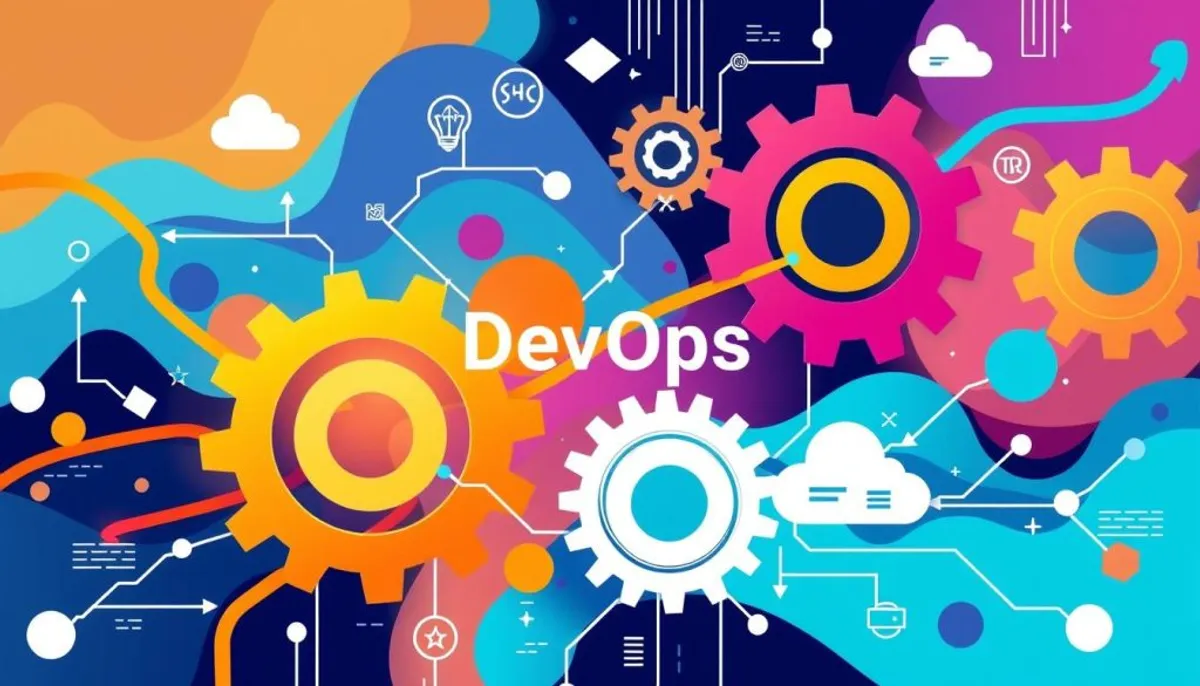In today’s fast-paced digital world, having efficient software development is key. DevOps is a new way that connects software development (Dev) and IT operations (Ops) teams. It uses practices, principles, and cultural ideas to help organizations make high-quality software faster. This includes working well with automation, continuous integration, and cloud computing.

DevOps encourages teamwork, automation, and shared responsibility between development and operations teams. This helps make the software development process smoother. It also makes software applications more reliable and gives users more value. This approach is changing the industry, helping companies stay ahead and flexible in a fast-changing digital world.
Key Takeaways
- DevOps is a set of practices that bridge the gap between software development and IT operations teams.
- The main goal of DevOps is to shorten the software development lifecycle and improve the quality and reliability of software applications.
- DevOps emphasizes collaboration, automation, and a shared sense of responsibility between development and operations teams.
- DevOps enables organizations to deliver high-quality software faster and stay competitive in the digital landscape.
- Adopting DevOps can lead to faster time-to-market, improved collaboration, and higher-quality software.
Introduction to DevOps
DevOps combines “development” and “operations” into one word. It’s a way to make software development and IT operations work better together. This method aims to improve how quickly and well software is made and delivered.
What is DevOps?
DevOps is all about making teams work together better. It uses continuous integration, delivery, and automation. The goal is to make the process of making and maintaining software faster and more efficient.
It also focuses on testing, monitoring, and getting feedback. This helps break down walls between development and operations teams. It makes the whole process smoother and more effective.
Bridging the Gap Between Development and Operations
Before, development and operations teams didn’t work closely together. This led to a big gap between making software and keeping it running. DevOps changes this by making teams work together more closely.
It encourages everyone to share goals and work together. This leads to faster and more reliable software delivery. It also makes the whole process of making software better and faster.
DevOps Benefits
Using DevOps best practices helps organizations improve their software development and operations. It makes things faster and better. Key benefits include quicker releases, better team work, and higher quality software.
Faster Time-to-Market
DevOps makes it quicker to release new features and updates. It automates many steps in the software delivery process. This means teams can get new products and fixes out faster.
This speed lets companies quickly meet customer needs and stay ahead in the market.
Improved Collaboration
DevOps promotes a team effort and open talks between developers and operations teams. This teamwork leads to better problem-solving and a sense of shared responsibility. It makes things run smoother and boosts productivity.
Higher Quality Software
DevOps uses automated testing and continuous delivery to improve software quality. It combines development and operations tasks. This helps find and fix problems fast, making software more reliable and efficient.
Overall, DevOps brings many benefits. It helps companies stay competitive, please customers, and save money in software development and deployment.
Key DevOps Principles
DevOps is built on three main ideas: working together, automating tasks, and always improving how we make and deliver software. These ideas help make the process smoother and more efficient.
Collaboration and Communication
DevOps brings development and operations teams closer together. It breaks down walls that once separated them. This way, everyone understands the big picture and works as a team to make great software.
Automation
Automation is key in DevOps. It cuts down on mistakes and speeds up how fast we can get software out there. By automating things like testing and setting up servers, teams can spend more time on new ideas.
Continuous Integration and Continuous Delivery
DevOps is all about continuous integration and continuous delivery. Continuous integration means adding new code to a shared place and checking it automatically. Continuous delivery takes it a step further by putting the tested code into use right away.

By following these principles, DevOps teams can make software development and delivery faster and better. They work together more effectively and deliver top-notch software quicker.
Automation in DevOps
DevOps automation is key to a successful DevOps setup. It automates tasks, making workflows smoother, more efficient, and speeding up software delivery. Continuous integration (CI) and continuous delivery (CD) are vital for smoothly adding and deploying code changes.
Using infrastructure as code (IaC) and configuration management tools is also important. These tools help teams set up and manage infrastructure consistently and efficiently. This ensures the IT environment is always set up right, no matter the environment.
| DevOps Automation Practices | Benefits |
|---|---|
| Continuous Integration (CI) | Automatically builds, tests, and integrates code changes, ensuring early detection of issues |
| Continuous Delivery (CD) | Automates the deployment process, allowing for frequent and reliable software releases |
| Infrastructure as Code (IaC) | Enables the consistent and repeatable provisioning of infrastructure, reducing manual errors |
| Configuration Management | Automates the management of system configurations, ensuring consistency across environments |
By using these DevOps automation practices, companies can make the most out of their DevOps efforts. This leads to quicker market entry, better teamwork, and better software quality.
DevOps
Continuous Integration (CI) and Continuous Delivery (CD) are key to DevOps. They automate the software delivery process. CI builds and tests code changes automatically when they’re added to the system. This catches problems early. CD then deploys these changes quickly and reliably, making new features and updates available fast.
Continuous Integration
Continuous Integration focuses on combining code changes often into a shared space. When a developer adds code, it starts an automated build and test. This catches problems early. Continuous integration makes merging code changes quicker, speeding up software delivery.
Continuous Delivery
After Continuous Integration, comes Continuous Delivery. It automates the software delivery process further. Once code passes the continuous integration tests, it goes straight to production. This lets teams release new features and updates fast and reliably.
CI/CD pipelines cut down the time it takes to get code to users. They also keep software quality high. This supports DevOps goals like faster delivery, better teamwork, and quality software.
Monitoring and Feedback Loops
In the fast-paced world of software development, continuous monitoring and real-time feedback are key. They help teams keep their software quality high and always improving.
Continuous Monitoring: Proactive Performance Tracking
Effective DevOps monitoring uses automated tools to watch how applications and infrastructure are doing. This lets teams spot and fix problems fast. It keeps the software running smoothly and helps users.
Real-Time Feedback: Enabling Timely Adjustments
Real-time feedback tools like automated tests and alerts give developers quick updates on their code changes. This helps them quickly adapt, making sure the software meets user and business needs.
By using continuous monitoring and real-time feedback, DevOps teams work in a culture of constant improvement. They make decisions based on data and change quickly. This approach is central to DevOps, making teams agile, reliable, and successful over time.

| Attribute | Continuous Monitoring | Real-Time Feedback |
|---|---|---|
| Purpose | Proactive performance tracking | Enabling timely adjustments |
| Tools | Automated monitoring solutions | Automated testing, notifications |
| Outcome | Early issue detection and resolution | Responsive software development |
DevOps Culture and Mindset
DevOps is more than just using new tools and tech. It’s about building a team culture that works together well. It brings together people from development, operations, and quality assurance. This helps everyone understand the whole process of making software.
This way of working means everyone feels responsible for the project’s success. It makes teams work better together towards common goals. Using an agile method and always improving, DevOps teams make software better and faster.
Cross-Functional Teams
DevOps teams mix people from different areas like development, operations, and quality assurance. This helps break down old barriers. It makes sure everyone knows how the software development process works.
Shared Responsibility
In DevOps, everyone on the team is responsible for the project’s success. This creates a sense of ownership and accountability. It helps teams adapt to changes and keep getting better.
| Characteristic | Traditional Approach | DevOps Approach |
|---|---|---|
| Team Structure | Siloed departments | Cross-functional teams |
| Responsibility | Clearly defined roles and boundaries | Shared ownership and accountability |
| Mindset | Rigid processes and hierarchies | Agile, collaborative, and continuous improvement |
DevOps Tools and Technologies
DevOps relies on many tools and technologies to make software development and deployment smooth. Let’s look at some key tools that help make DevOps work well.
Version Control Systems
Git is a big part of DevOps. It helps teams work together, track changes, and keep a record of the project’s history. With Git, developers can work on the same code at the same time, merge changes, and solve conflicts easily.
Continuous Integration and Continuous Deployment (CI/CD) Platforms
CI/CD platforms like Jenkins, GitLab CI, and CircleCI are key to DevOps. They automate the build, test, and deployment of software. This means faster updates and better quality software.
Containerization and Orchestration
Docker and Kubernetes are big in DevOps. They help create and manage software environments that are scalable and consistent. Developers can put their apps and dependencies into containers. This makes sure the app works the same everywhere, from testing to production.
Cloud Computing and Infrastructure as Code
Cloud services like Amazon Web Services (AWS) and Microsoft Azure are key for DevOps. With tools like AWS CloudFormation and Terraform, teams can easily set up and manage their infrastructure. This makes the DevOps process better.
| DevOps Tool | Purpose |
|---|---|
| Git | Version control system |
| Jenkins | Continuous Integration and Continuous Deployment (CI/CD) platform |
| Docker | Containerization technology |
| Kubernetes | Container orchestration platform |
| AWS CloudFormation | Infrastructure as code (IaC) tool |
| Terraform | Infrastructure as code (IaC) tool |
These are just a few tools that are important for DevOps. Using these, teams can make their work faster, improve teamwork, and create better software.
Conclusion
DevOps changes how software development and IT operations work together. It makes the whole process smoother. By focusing on teamwork, using automation, and continuous updates, companies can make their software better and faster.
DevOps is all about working together. Developers and operations teams join forces, ending the old silos. This teamwork, with automation tools, cuts down on manual work, lowers mistakes, and speeds up software releases.
As DevOps grows, with new trends like AI/ML and DevSecOps, companies that adopt it will lead in the digital world. By always improving and using the newest tools, they can stay ahead and give customers the best experiences.
RelatedRelated articles

